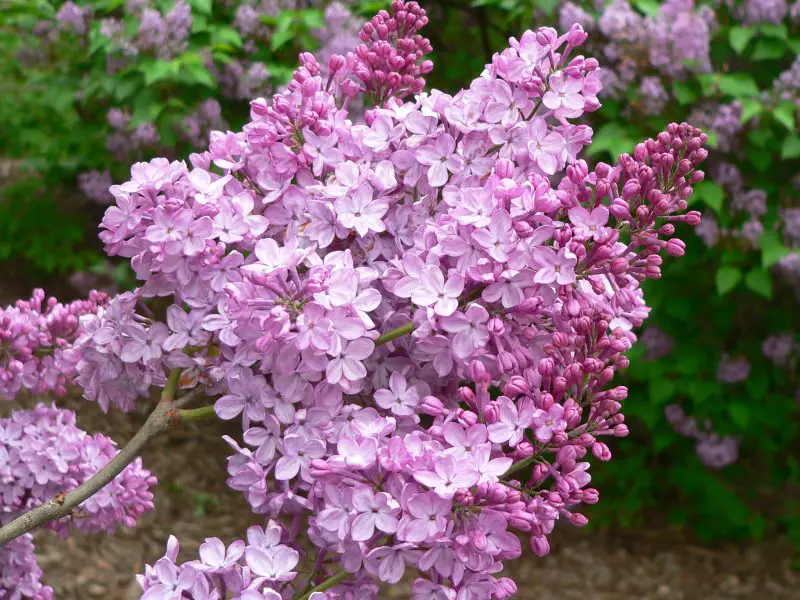There’s nothing quite like the nostalgic scent and soft pastel beauty of lilac bushes in full bloom. Whether you’re planning to start a fragrant hedge or add a splash of spring color to your garden, knowing when to plant lilac bushes can make all the difference between a thriving display and a disappointing one.
Timing is the secret to lilac success. Planting them at the right time ensures strong roots, abundant blooms, and lush foliage for years to come. In this guide, you’ll discover the best seasons to plant lilac bushes, what conditions they need to flourish, and how to give your shrubs the strongest start possible.
Understanding Lilac Growth Requirements

To ensure lilac bushes thrive and produce their iconic blooms, it’s essential to understand the key conditions they need throughout their life cycle. Lilacs are relatively low-maintenance once established, but they do have specific preferences that directly affect their growth, flowering capacity, and longevity.
Lilacs require full sun to reach their blooming potential—ideally six or more hours of direct sunlight per day. While they can tolerate partial shade, limited light often results in fewer flowers and leggier growth. Well-draining soil is another essential factor. Lilacs dislike soggy or compacted soil, which can lead to root rot and stunted growth. They prefer slightly alkaline to neutral soil (pH 6.5 to 7.5) that’s rich in organic matter, such as compost or aged manure.
Air circulation is also important. Proper spacing between bushes allows for better airflow, reducing the risk of powdery mildew and other fungal diseases. Overcrowding can lead to poor blooming and stress the plant over time.
Watering needs are moderate. While young lilac bushes require consistent moisture as they establish, mature plants are fairly drought-tolerant. Overwatering should be avoided, especially in poorly drained areas. Adding mulch around the base helps retain moisture while preventing weeds.
Finally, lilacs benefit from a balanced fertilizer in early spring, particularly if the soil lacks nutrients. However, avoid high-nitrogen fertilizers, as they promote leafy growth at the expense of blooms. By meeting these growth requirements, you’ll lay the foundation for vigorous lilac shrubs that bloom beautifully each spring.
Best Time to Plant Lilac Bushes: Seasonal Considerations
Choosing the right season to plant lilacs plays a pivotal role in their establishment and bloom success. While lilacs can be planted in both spring and fall, each season has advantages and disadvantages.
Planting Lilacs in Spring
To make the most of spring planting, timing is critical. Aim to plant lilacs after the last expected frost but before temperatures consistently rise above 26°C. This window typically falls between mid-March and early May, depending on your local climate. Start by preparing the soil well in advance—loosen it to a depth of at least 30 cm and amend it with compost if needed to ensure good drainage and fertility.
When placing your lilac in the ground, dig a hole twice as wide as the root ball and no deeper than the root collar. After planting, water deeply and apply a light mulch layer to retain moisture while keeping the base of the stem free of mulch to prevent rot. Monitor the plant closely for signs of drought stress, especially during spring dry spells. Consistent watering is essential until the root system establishes, but avoid overwatering.
In the first year after spring planting, you may not see many blooms—this is normal. Most of the energy is going into developing roots. With proper care, your lilac should bloom more reliably by the second spring.
Planting Lilacs in Fall
Early fall, ideally from late September through October, is the best time to plant lilacs in most zones. At this point, soil is still warm enough to encourage root development, while the air is cool enough to reduce stress on the plant. Avoid planting too close to your region’s first hard frost date to give your lilac time to establish.
Before planting, clear the area of weeds and test the soil’s drainage. If water pools in the planting hole, amend with sand or compost to improve aeration. Once planted, water thoroughly to eliminate air pockets and encourage root contact with the soil.
Mulching is especially important for fall plantings, as it protects young roots from early freezes. Apply a 5–7 cm thick layer of organic mulch around the base, extending out to the drip line. In colder regions, consider adding a thicker mulch layer after the ground freezes to insulate against extreme winter temperature swings.
With fall planting, lilacs often experience less transplant shock and can focus energy entirely on root establishment rather than top growth. While they may not appear very active above ground over the winter, they’ll be ready to grow vigorously come spring.
Climate Zones and Their Impact on Planting Time
Lilacs thrive in USDA hardiness zones 3 through 7 but can adapt to others with proper care. Understanding your local climate is vital to choosing the best planting window.
Cold Climates (Zones 3-5)
For gardeners in cold regions, such as the northern U.S. or parts of Canada, lilacs are well-suited thanks to their high tolerance for chilly winters. These climates provide the cold dormancy period lilacs require to bloom profusely in spring. However, timing is everything. Planting in early spring, just after the ground has thawed, allows young lilacs to root before facing late frosts or sudden cold snaps.
Fall planting is possible but risky if delayed too long. The key is to get the shrubs into the ground at least six to eight weeks before the first hard freeze. This gives roots time to acclimate and develop before the soil locks up. Adding a layer of mulch can also protect young roots from extreme cold.
Moderate Climates (Zones 6-7)
In moderate climates with four distinct seasons, lilacs flourish with fewer temperature extremes to contend with. Spring remains a great time to plant, but many experienced gardeners in these zones prefer early fall. Why? The cooling temperatures combined with steady rainfall create ideal conditions for root establishment with less need for intervention.
Fall-planted lilacs in zones 6 and 7 often show strong spring growth and may bloom slightly earlier than spring-planted counterparts. However, if planting in spring, it’s best to get started as early as possible—ideally in March or April—before heat and humidity ramp up. Consistent watering is especially important in drier areas.
Warmer Climates (Zones 8 and above)
Lilacs aren’t naturally adapted to hot, humid regions, but they can still grow with the right care. In these areas, choosing the right variety—such as ‘Blue Skies,’ ‘Lavender Lady,’ or ‘Miss Kim’—is essential, as these are bred to tolerate warmer conditions. Spring is by far the best planting time in these zones because it gives lilacs a chance to settle before summer brings intense heat.
Since lilacs need a certain number of chill hours to bloom, not all varieties will flower well in southern climates. Planting in a spot with afternoon shade, especially near a north- or east-facing wall, can help keep roots cooler. Good drainage, a thick layer of organic mulch, and deep watering are non-negotiable if you want to see your lilac survive—and eventually bloom—even in zone 8 or 9.
Preparing the Soil for Lilac Planting
Lilacs perform best in loose, well-draining soil that is rich in organic matter and slightly alkaline, with a preferred pH range of 6.5 to 7.5. Before planting, it’s a good idea to conduct a simple soil test to determine both pH and drainage quality. If the pH is too low (acidic), you can raise it by adding garden lime several weeks in advance of planting.
To prepare the site, loosen the soil to a depth of at least 12 to 18 inches. Remove any compacted clumps, debris, or rocks that could hinder root development. If your soil is heavy clay or tends to retain water, improve its texture by incorporating coarse sand, perlite, or compost. This boosts drainage and helps prevent root rot, a common issue in poorly drained locations.
Enriching the planting area with well-rotted manure or aged compost provides essential nutrients that support healthy establishment and early growth. After amending the soil, allow it to settle for a few days before planting your lilac bush. Proper soil preparation lays the foundation for strong roots and vibrant blooms for years to come.
How to Plant Lilac Bushes for Success
Start by choosing a sunny spot with good air circulation—lilacs need at least six hours of direct sunlight daily to bloom well. Once you’ve prepared the soil, dig a hole twice as wide and just as deep as the root ball. Gently loosen the roots if they’re tightly packed, then place the bush in the hole so the top of the root ball is level with the ground surface.
Backfill with amended soil, pressing down lightly to eliminate air pockets. Water deeply after planting to settle the soil and help the roots make contact with moisture. If planting more than one bush, space them 5 to 15 feet apart, depending on the mature size of the variety.
Mulch around the base with 2 to 3 inches of organic material to retain moisture and regulate soil temperature. Avoid piling mulch against the stem, which can lead to rot. Finally, keep the soil evenly moist for the first few weeks as the lilac establishes, especially during dry spells. Proper planting ensures a strong start and vibrant blooms in seasons to come.
Caring for Newly Planted Lilacs
After planting, lilacs need consistent care to establish healthy roots and prepare for future blooming. Watering is especially critical during the first growing season. Keep the soil evenly moist, but not soggy, by watering deeply once or twice a week, depending on rainfall and temperature. Use a soaker hose or gentle spray to reach the root zone without compacting the soil.
Fertilizing is not usually necessary in the first year, especially if you’ve amended the soil with compost. In fact, over-fertilizing—particularly with high-nitrogen products—can lead to lush foliage at the expense of flowers. If needed, apply a balanced, slow-release fertilizer in early spring of the second year.
Keep the area around the plant weed-free and apply a 2- to 3-inch layer of mulch to conserve moisture and regulate temperature. Make sure the mulch stays a few inches away from the stem to prevent rot and pest problems.
Avoid pruning during the first year unless it’s to remove damaged or dead branches. Let the plant focus its energy on root establishment. In the fall, reduce watering gradually as the plant goes dormant, and avoid heavy feeding or pruning late in the season.
Protect young lilacs from harsh winter winds with a windbreak or burlap wrap if you’re in a colder zone. With the right care in this critical first year, your lilac bush will develop a strong foundation for years of fragrant, vibrant blooms.
Common Mistakes to Avoid When Planting Lilacs
Planting lilacs seems straightforward, but several common mistakes can affect their growth and flowering potential for years to come. One of the most frequent errors is planting too deeply. Unlike some shrubs, lilacs should have their crown—where the stems meet the roots—positioned right at or slightly above the soil line. Planting too deep can lead to poor airflow around the base and increase the risk of rot or disease.
Another widespread mistake is choosing the wrong location. Lilacs need full sun—at least six hours per day—to bloom abundantly. Placing them in partial or full shade might result in lush foliage but few, if any, flowers. Similarly, planting in poorly drained or compacted soil can suffocate the roots. Lilacs prefer loose, well-drained soil that’s neutral to slightly alkaline; if the soil is too acidic or heavy with clay, growth can be stunted and blooms limited.
Spacing is also critical. Some gardeners place lilacs too close to fences, buildings, or other shrubs. Without good airflow between plants, lilacs are more prone to powdery mildew and fungal problems. Inadequate spacing can also lead to overcrowding as the bush matures, forcing you to prune heavily or even relocate the plant later.
Lastly, skipping soil preparation and amending only at the time of planting can set lilacs back. They thrive best in soil that has been gradually improved, not suddenly altered with excessive compost or fertilizer. Avoiding these simple but impactful mistakes ensures your lilac bushes establish well and reward you with healthy, fragrant blooms for years.
Signs Your Newly Planted Lilac Is Thriving
A healthy lilac bush will show early signs of successful establishment through vibrant green leaves and steady new growth. If young leaves appear fresh and full, without yellowing or wilting, it’s a strong indicator that the roots are functioning well and absorbing nutrients.
New shoots or branch extensions are another sign that the plant is adapting and developing as expected. Though lilacs often don’t bloom in their first year, the formation of small buds by the next spring suggests the plant is on track for strong flowering seasons ahead.
In addition, a thriving lilac will maintain an upright shape, show good tolerance to environmental stress, and display lush, pest-free foliage. These combined signs confirm that your newly planted shrub is healthy and growing into its full potential.
When to Expect Lilacs to Bloom After Planting
Lilacs are not fast bloomers, and patience is key after planting. Typically, a newly planted lilac bush will take between 2 to 5 years to produce its first significant blooms, depending on the variety, growing conditions, and whether it was planted from a bare root, container, or as a more mature shrub.
Container-grown lilacs that are already a few years old may bloom within 1 to 2 seasons if given proper care. In contrast, bare-root lilacs or very young plants often need several years to establish a strong root system before allocating energy to flower production.
Environmental factors also play a major role in bloom timing. Adequate sunlight—at least six hours a day—is essential. Poor pruning practices, lack of nutrients, or overly shady conditions can delay blooming even longer. With consistent watering, well-balanced fertilization, and proper pruning after flowering, most lilacs reward gardeners with abundant, fragrant blossoms each spring once established.
Additional Tips for Long-Lasting Lilac Health and Blooms
To keep your lilac bushes healthy and blooming profusely for years, consistent care is essential. Start by ensuring your lilacs get full sun—at least 6 to 8 hours of direct sunlight daily. Shade can lead to fewer blooms and increase the risk of disease due to trapped moisture. Also, plant them in well-draining soil, as lilacs dislike soggy roots, which can cause rot and stunt growth.
Deadheading spent flowers right after blooming helps redirect the plant’s energy into growth and future bud development rather than seed production. However, do this carefully and only immediately after blooming, since lilacs set their buds for next year soon after flowering.
Regular pruning is crucial not only for shaping the bush but also for stimulating fresh growth and flower production. Remove dead, weak, or overcrowded stems at the base to improve air circulation and light penetration.
To support long-term vitality, apply compost or a balanced slow-release fertilizer in early spring, just before new growth appears. Avoid high-nitrogen fertilizers, which promote leafy growth at the expense of flowers. Every few years, refresh the mulch around the base with organic material to conserve moisture and suppress weeds, but keep it away from the trunk to prevent rot.
Finally, keep an eye out for signs of pests or disease. Powdery mildew, borers, and scale insects are common threats. Prompt treatment and proper cultural care can usually keep these in check. With attention to these details, your lilac will continue rewarding you with vibrant blooms and a sweet fragrance season after season.
FAQ About When to Plant Lilac Bushes
Can I plant lilac bushes in the fall, or is spring better?
Yes, lilacs can be planted in both spring and fall. Spring is often preferred in colder regions because it gives the plant time to establish roots before summer heat arrives. Fall planting can also work well if done at least six weeks before the ground freezes, ensuring enough time for root growth.
How long does it take for a newly planted lilac to bloom?
Lilacs usually take 2 to 5 years to bloom after planting, depending on their size and maturity. A larger, well-established plant might bloom the first or second year, while smaller or bare-root lilacs need more time to develop a strong root system before flowering.
What is the best time of day to plant lilacs?
Early morning or late afternoon is the ideal time to plant lilacs. These cooler parts of the day help minimize transplant shock and water evaporation, giving the plant a gentler transition into the soil.
Should I fertilize lilacs when planting them?
Avoid using strong fertilizers when first planting lilacs. Instead, mix compost or aged manure into the soil to improve drainage and nutrient content. Fertilize lightly with a balanced formula in the second year if growth is slow or leaves appear pale.
Can I grow lilacs in containers, and does that change the planting time?
Lilacs can grow in large containers, especially compact or dwarf types. The planting time remains the same—early spring or fall—but potted lilacs need well-draining soil, full sun, and more regular watering. In cold climates, protect containers from freezing temperatures over winter.
Conclusion
Planting lilac bushes at the right time of year and preparing the soil properly are the foundations for a thriving, fragrant garden centerpiece. Whether you choose spring or fall planting depends on your climate, but both can be successful with the right care. Patience and attention in the early years reward you with vibrant, long-lasting blooms that fill your garden with beauty and scent for decades.






